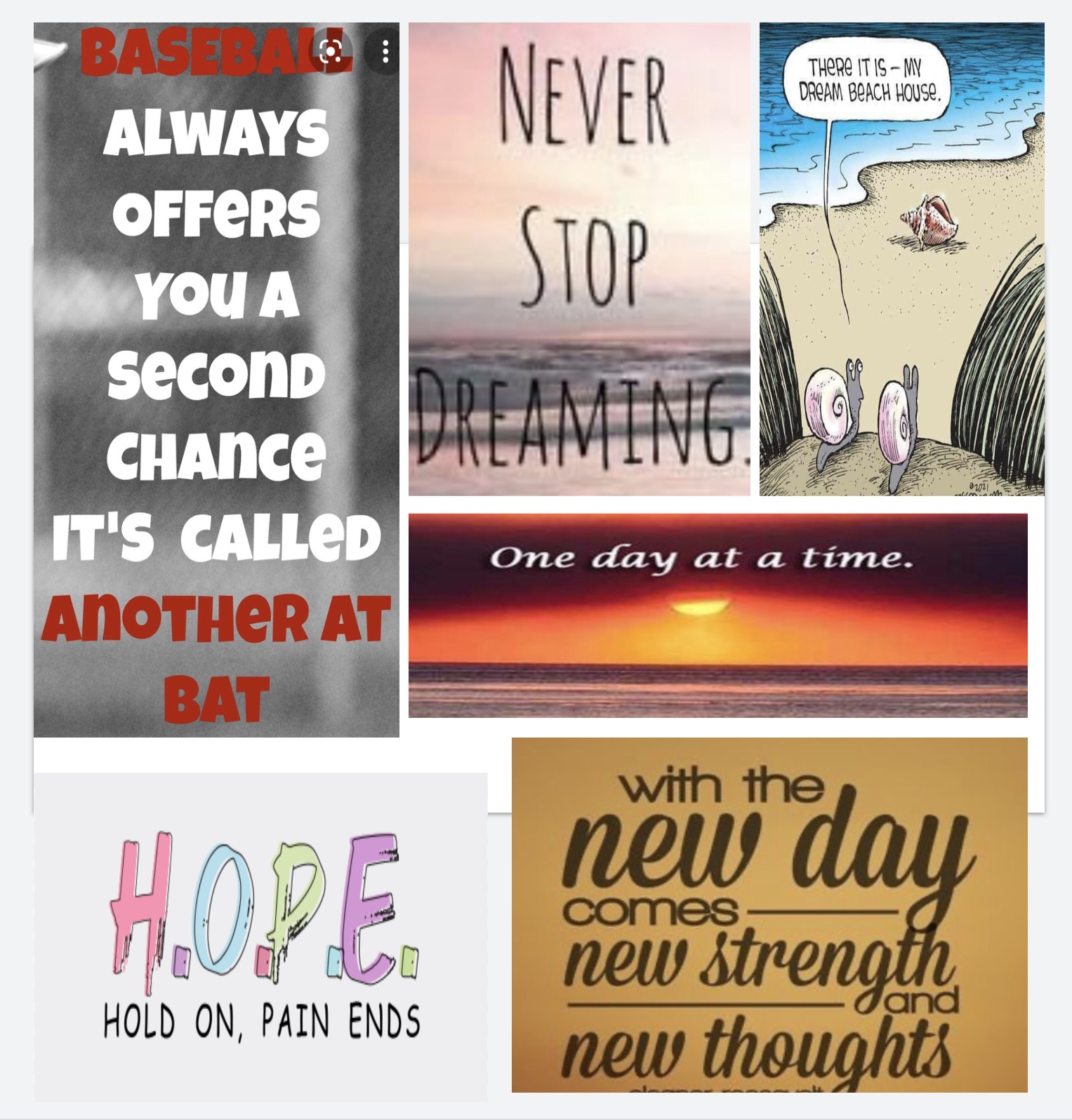
HITTING ELITE PITCHING IS ”HARD TO DO”
When you face the #1 pitcher or closer in a weekend series who has either a nasty 4 seam fastball or a great riseball, you are in for a tough battle which will probably include some failures (swing & misses, some good takes, some mishits, chases out of the zone, takes of strike three, etc.) – all as seen above. The focus of this article is whether offensively, hitters should prepare to have a HIT APPROACH OR TAKE APPROACH when these match-ups occur.
THE “TAKE APPROACH” TO THE RISEBALL
The advice in softball circles for a long time & still now about how to hit a riseball is, “lay off the riseball”– “the best way to hit the riseball is to NOT SWING AT IT”. An example of this advice is Alabama’s twitter from last season about this time (03/16/21).
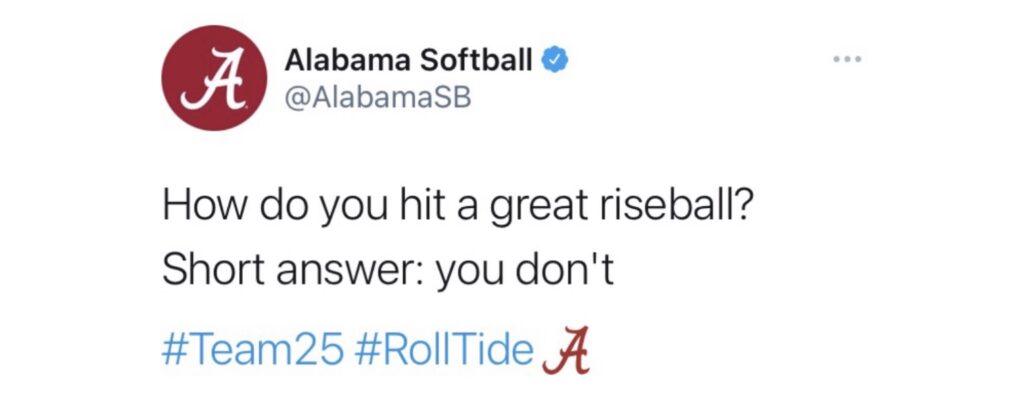
- The ”take approach” to the riseball (regardless of whether it was a one year swing approach or a program philosophy) has won a lot of games and in Alabama’s case, a national championship.
- Most softball coaches believe that many riseballs cross the plate out of the strike zone, which of course many do.
- The same question can be asked in MLB: how do you hit a great 4 seam fastball approaching 100 m.p.h. with vertical break?
- I’ve heard softball coaches proclaim: “Not many Division 1 pitchers can throw a really good LOW RISE” or in other words, cannot throw true backspin consistently for a strike.
- But from my experience, MOST EVERY D1 pitcher we faced could “LADDER” the riseball. In other words, once they perfected the backspin and could create vertical break then they certainly could “command” the location;
- These pitchers could throw the riseball to 3-4 different levels –
- LEVEL #1: mid-thigh to the hitter’s waist (considered a “low rise”, working it inside and outside and always a strike;
- LEVEL #2: waist high to belly button (working the top of the umpire’s strike zone);
- LEVEL #3: from the belly button to the chest which is the CHASE PITCH usually in pitcher friendly counts, thrown as a swing and miss pitch &/or as a set-up pitch to change the hitter’s eye level for the next pitch; and
- LEVEL #4: what Jennie Finch is throwing Albert Pujols in the video below- pitches from the top of the chest to shoulder level and what a good softball hitter calls a WASTE PITCH & a good softball pitching coach calls a non-competitive pitch because it is so easily recognizable as a ball and good softball hitters will not be fooled by often.
CHASE RISEBALLS/LEVEL #4 are balls out of the strike zone AND are UNHITTABLE.
LEVEL #3 riseballs require lots of practice and preparation to develop plate discipline & visual processing/pitch recognition skills to keep from enticing the hitter to chase after it the higher and higher it gets out of the zone. It also requires great adjustments and lots of practice to develop the hitter’s swing mechanics in order to NOT swing and miss underneath it.
Lots of advocates in favor of the TAKE APPROACH TO RISEBALLS use the example of Jenny Finch striking out Albert Pujols (WATCH the video below) as argument basically stating, “if Pujols cannot hit it then my hitter surely will not hit it either”.
Noteworthy observations and comments from the above video:
- Albert is smart enough to know that he is getting set up by Jennie Finch on that high, hard one.
- Pujols has no chance.
- This game is hard; VERY HARD.
- Look at where the catcher is receiving the pitch.
- She is so good …..
Here is some comical advice for Pujols from Haley Cruz so next year, he will hopefully be ready for it.
THE “HIT APPROACH” FOR THE RISEBALL
- Bonds asks: “How many pitches do you have?”
- Next, after watching all of Jennie’s pitches from the mound, he asks, “CAN I STAND IN?”
- ”I JUST WANT TO SEE IT”.
- After watching 3 or 4, he says, “Don’t tell me what’s coming”; IOW, he wants to see when he visually processes the incoming pitch.
- Then he is mapping in his mind to what he is seeing, “That ain’t no curveball, that’s a slider”.
- NEXT, it’s starting to get REAL — BALL OR STRIKE? MLB Strike Zone based on what Bonds is used to OR college softball Strike Zone based on what Jennie is accustomed to.
- Then Bonds starts syncing his actions/decisions/mechanics (tapping the ball with his bat) based on his visual processing.
- Lastly, MUTUAL RESPECT of two fierce competitors — THE BEST OF THE BEST.
4 SEAM FASTBALLS IN BASEBALL
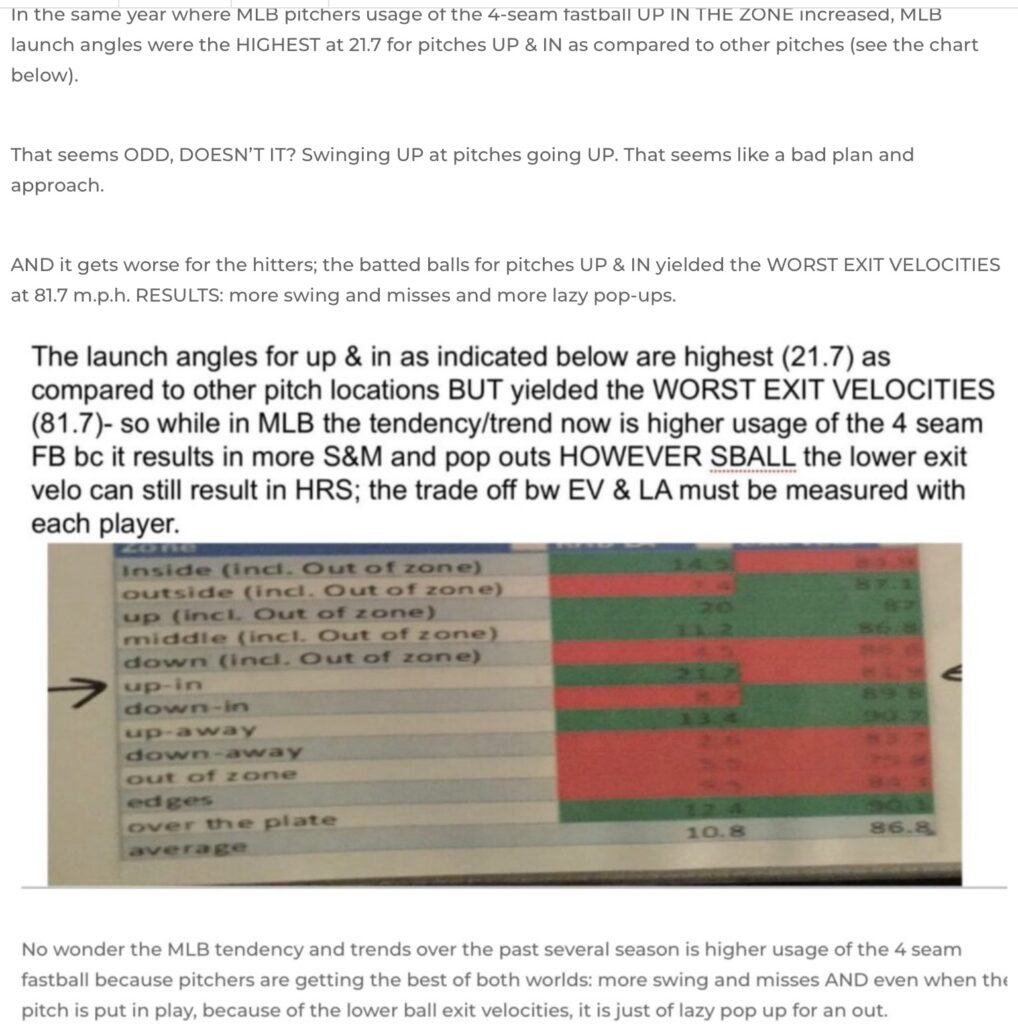
DESIGNING AND EXECUTING A HITTING PLAN
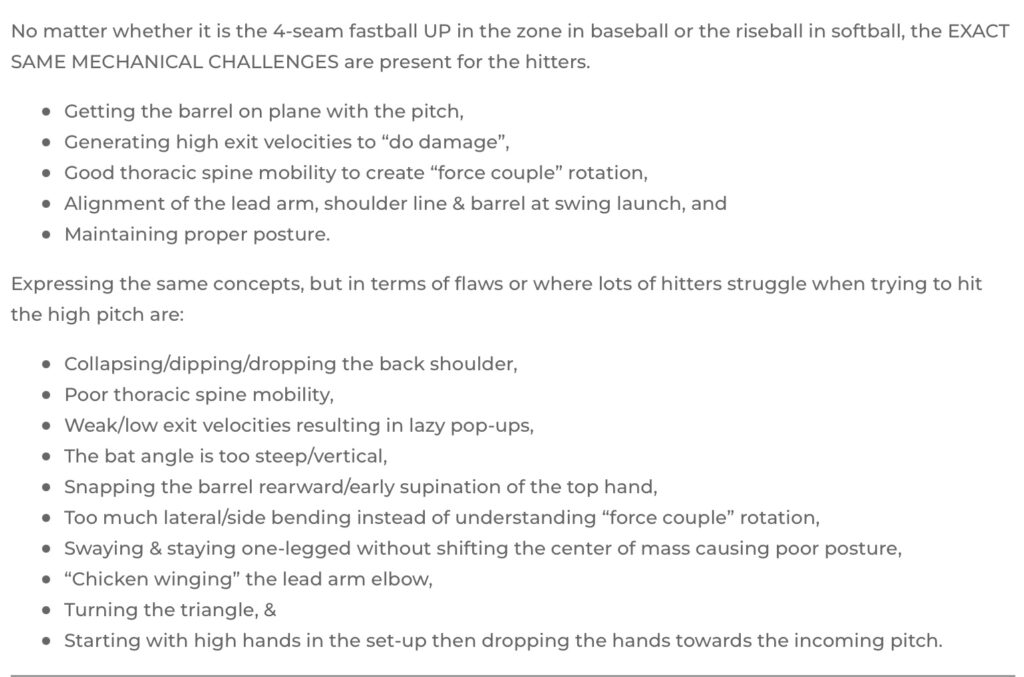
Designing and executing a hitting plan starts with the philosophy: TAKE OR HIT THE RISEBALL, which then carries over into practice protocols.
So, if you plan on TAKING THE RISEBALL in the game, then you PROVE in practice that you can recognize that pitch and lay off. If you plan to swing at riseballs in the game then you need to PROVE IN PRACTICE and your preparations – during actual game-like, simulated scrimmages with realistic riseballs that you can get on plane and ”do damage”.
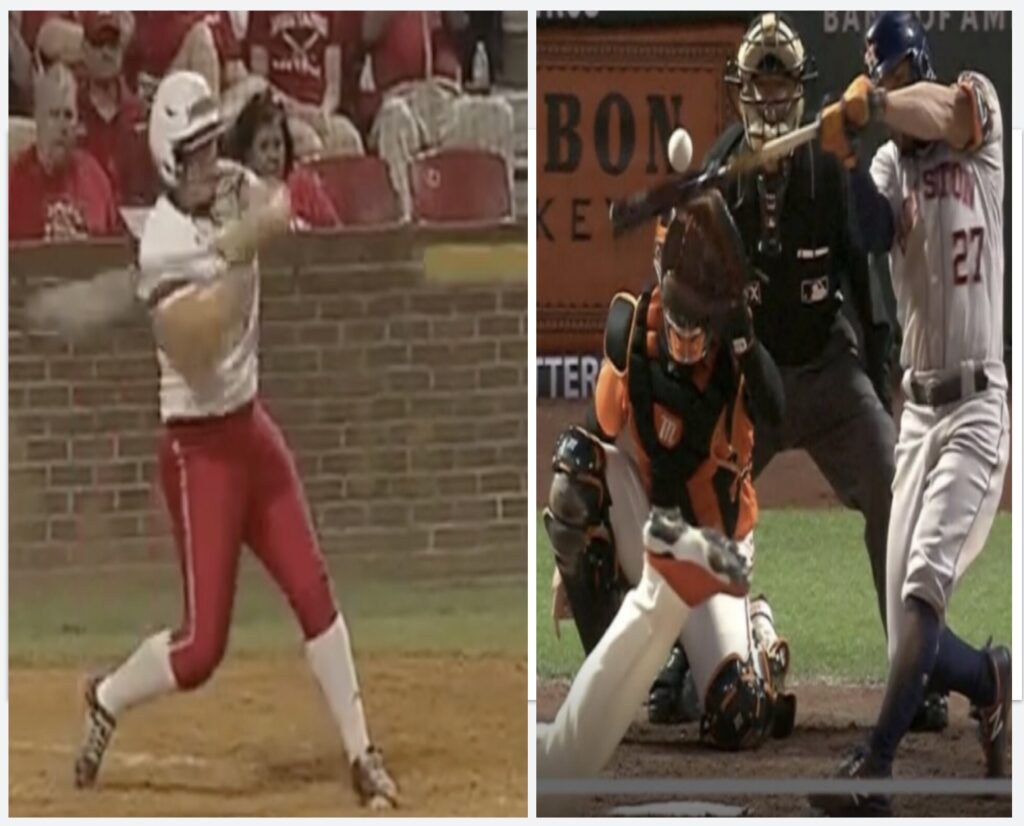
WHAT’S THE PLAN TO SCORE AGAINST A GREAT RISEBALL PITCHER
What about the riseballs at the top of the strike zone being called a strike by the umpire? LEVEL #2 riseballs? Does the hitter just take those riseballs for strikes too? Or is there a better plan?
Taking Level #2 & #3 riseballs never “sat right with me”, because I always believed that the riseball flattened out towards the top of the strike zone resulting in a high percentage of home runs especially since the pitch is elevated and the fence is only 200 feet away. Due to the height and trajectory of the pitch, hitters can easily “lift” (get launch) the riseball.

When I got to UL in 2001, I noticed a lot of elite college pitchers threw about 50% of their pitches up in the zone. I knew if we could get on plane with ELEVATED VELOCITY it would be easy to hit that pitch out of the park.
In fact, in 2002, we got a chance to play Arizona and face Jennie Finch (thanks to Coach Candrea inviting us there and hosting us). Wow, Jennie was good; really good; probably “the best ever”, and she just “mowed us down” — and through that experience and failing miserably, MY GUT INSTINCTS HARDENED AND MY CONVICTIONS AND BELIEFS BECAME MORE RESOLUTE THAT A “HIT APPROACH” TO AN ELITE PITCHER’S RISEBALL WAS THE BETTER PLAN RATHER THAN A “TAKE APPROACH”.
My gut and my mind told me that if we “got on plane” with a caliber pitcher’s LEVEL #1 & LEVEL #2 RISEBALLS (and sometimes even LEVEL #3) and we were on time, then we could do damage. That was our best chance to score runs in my opinion going forward.
So my journey began to figure out the best swing mechanics to help my hitters not only get on plane and be on time, but also generate enough power and bat speed to hit the elevated fastball out of the park. Swing Attractors is my attempt to document that journey and share some ideas so if you decide that a HIT APPROACH rather than a TAKE APPROACH for the riseball/4 seam fastball is best course, then your hitters can have as much success as ours did.
HOPE IS EVERYTHING
Becky McMurtry, our All-American 3rd basemen, gave me hope and proved during that Arizona series that my theory had possibilities —- in 7 at bats against Jennie Finch in the three game series, Becky hit 3 HOME RUNS. (I could not find this specific video archived, nor did U.L. keep track of those magical softball moments; so part of the reason I undertook this project was to archive as many videos of my former players that I still have for future reference and enjoyment and discussion for the next generation).
I found the next best thing to the actual video of Becky hitting those 3 home runs off of Jennie Finch; during the 2003 WCWS, Jenny was the color commentator for ESPN and Beth Mowins brought up the topic – LISTEN TO THAT FUNNY EXCHANGE BELOW.
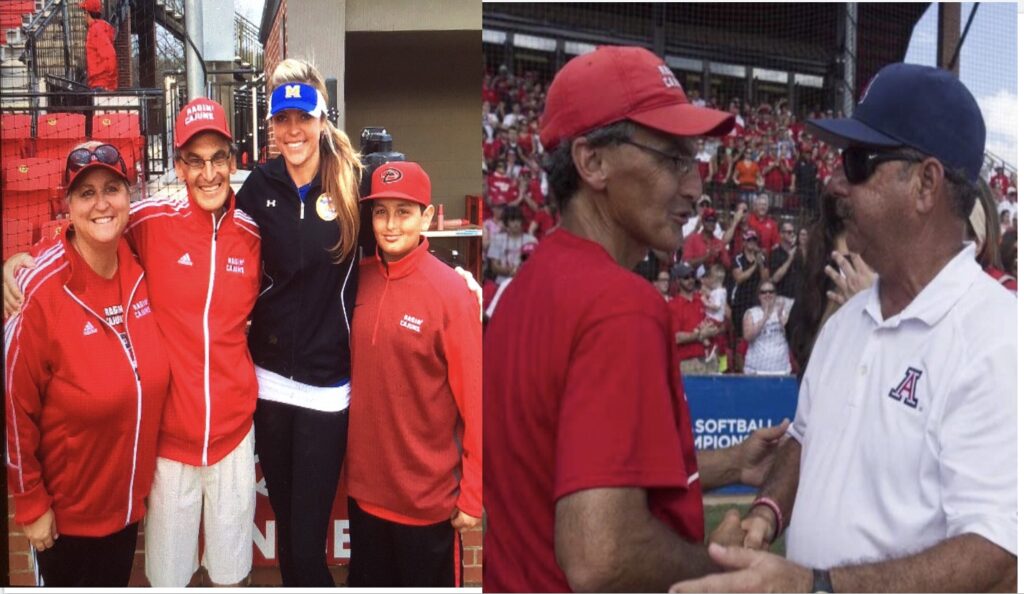
PLAYER PROFILE: BECKY McMURTRY
Becky McMurtry was a 2-time letter winner at UL in 2002 & 2003 for co-head coaches Stefni & Mike Lotief, after transferring to UL because her brother, Danny, was a pitcher on the UL Baseball team.
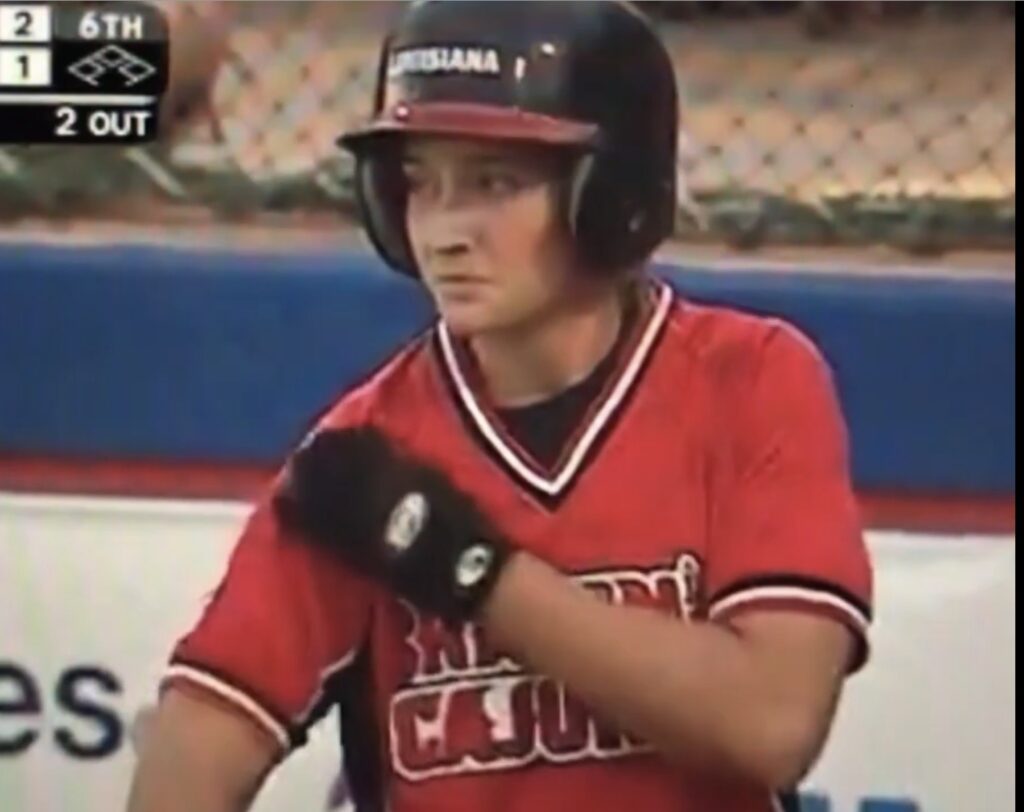
While on the way to being named the 2002 Sun Belt Player of the Year and a consensus ALL-AMERICAN, Becky McMurtry hit three home runs off future USA Olympic gold medalist pitcher, Jennie Finch, in a three-game series against Arizona in Arizona, March 22-24. Becky was 4-for-7 with three home runs off of the Arizona All-American pitcher. During that season (her junior season) she set the school’s single season records for total bases (151), extra base hits (40), and slugging percentage (.766).
As a senior, she lead her team to the 2003 WCWS.
Becky was named OUTSTANDING GRADUATE at UL in 2003, receiving her degree in education; she also completed her anesthesiology curriculum; she is daughter of Jim and Sally McMurtry from North Platte, Nebraska.
CONCLUSION
Changing the mindset with our hitters (over the subsequent 15 years) from “not swinging at the riseball” to “getting on plane with it” proved to be a HUGE ADVANTAGE & OPPORTUNITY FOR US! Designing and executing a hitting plan and challenging practice protocols with actual game-like, simulated, realistic riseballs was the key for the growth and development of our hitters.
PURSUE EXCELLENCE & WIN THIS PITCH!
About the Author

Mike Lotief coached 17 successful years as either the head softball coach or co-head softball coach with his wife Stefni Whitton Lotief at the University of Louisiana from 2002-2017 with an overall coaching record of 731-176 (80.6 winning percentage). Every season, the Ragin Cajuns softball team advanced to the NCAA tournament and also advanced to three (3) Women’s College World Series (2003, 2008, 2014) and from 2012-2016 advanced to five (5) straight NCAA Super Regionals. Coach Lotief produced over 40 All American selections and his 2017 team lead the nation in scoring and was ranked in the Top 10 in home runs, slugging percentage, on base percentage.
The coach is a cancer survivor (twice) and was the first person in the U.S. to receive the Pro Trach device. Mike and Stefni spearheaded and raised the funding to build the new softball stadium in 2009 and the new softball indoor hitting facility in 2015. They are proud parents to Chelsea, who played softball and graduated from the Univ. of Louisiana in 2018, and Andrew, who is a junior at Louisiana studying Mechanical Engineering.
Previous Articles in this Series
- The Mental Swing Attractors: Failure Cannot Break You (Nov. 11, 2021)
- Training Insights: “Swing Attractors” by Coach Mike Lotief… the Flaws of Pelvic Loading (Nov. 9, 2021)
- The Mental Swing Attractors: Push Yourself… You Don’t Have to Be #1 to BE #1! (Nov. 4, 2021)
- Training Insights: “Swing Attractors” by Coach Mike Lotief… Pelvis Loading, Part 2—The Planes of Movement (Nov. 2, 2021)
- The Mental Swing Attractors: Remove the Rope from Your Ankle & Get Rid of the Limiting Beliefs! (Oct. 28, 2021)
- Training Insights: “Swing Attractors” by Coach Mike Lotief… Pelvis Loading, Part 1—It’s All in the Hips (or Somewhere Deep Below) Oct. 26, 2021
- The Mental Swing Attractors: Champions are Developed by Devotion & Discipline! (Oct. 21, 2021)
- Training Expertise: “Swing Attractors”… the Secrets of Power Hitting by Coach Mike Lotief (Oct. 19, 2021)
More About Mike Lotief
- Why Michael Lotief is a Legendary Coach? by Jay Patel
- The Secret To Michael Lotief’s Success. By Jay Patel
- Michael Lotief Fights for Rajin’ Cajuns by Graham Hays ESPN
- Michael Lotief: Taking His Sport to New Heights by Neha Kapoor
- For the Love of the Game: A Look at Ragin’ Cajun Softball’s Power Couple
- How Louisiana-Lafayette’s Michael Lotief Develops Hitting Gems by Graham Hays ESPN
